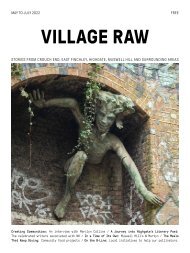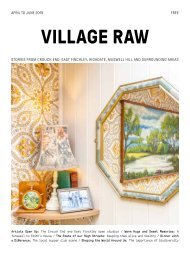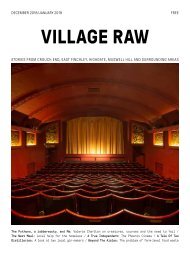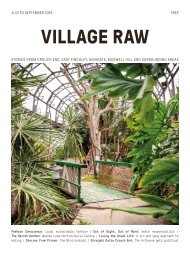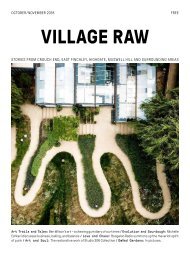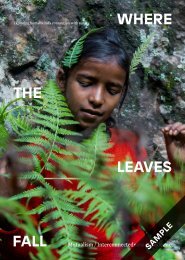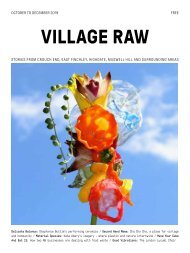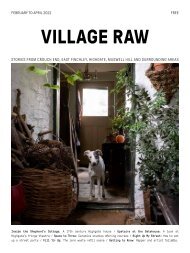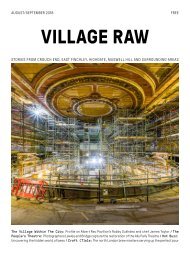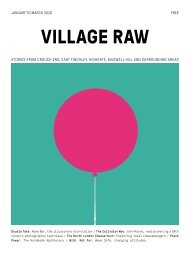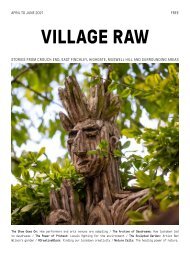Village Raw - ISSUE 1
Village Raw is a magazine that explores cultural stories from Crouch End, East Finchley, Highgate, Muswell Hill and the surrounding areas. The magazine is created by the community, for the community. If you like this issue you can support the project through a subscription or donation. See the links below. The first issue of Village Raw magazine includes: WOMEN ONLY - Female artists explore the role women have played in Highgate’s history. CRAFTING THE FUTURE - Local crafters championing handmade products. VILLAGE SOUNDS - Q&A with local musicians Gabriella Swallow and Luke Eira. CREATIVITY IS POWER: Rickardo Stewart discusses youth provision and outreach. IN LIMBO: Photographer Dan Bridges captures the essence of Hornsey Town Hall. AN UNDERTONE OF HARMONY - Chriskitch’s Chris Honor discusses harmony. WALK AND TALK (AND EAT) – The Walk and Talk Club. THE HERBAL HOME - The herbal essentials that every home’s medicine chest should have. THE LAST STRAW - N8’s war on single-use plastic. NOT YOUR USUAL SALAD - A recipe from the Sustainable Supper Club. VILLAGE ESSAY - Mina Aidoo writes On Being Human: Learning to Feel Again. AND MORE…
Village Raw is a magazine that explores cultural stories from Crouch End, East Finchley, Highgate, Muswell Hill and the surrounding areas. The magazine is created by the community, for the community. If you like this issue you can support the project through a subscription or donation. See the links below. The first issue of Village Raw magazine includes:
WOMEN ONLY - Female artists explore the role women have played in Highgate’s history.
CRAFTING THE FUTURE - Local crafters championing handmade products.
VILLAGE SOUNDS - Q&A with local musicians Gabriella Swallow and Luke Eira.
CREATIVITY IS POWER: Rickardo Stewart discusses youth provision and outreach.
IN LIMBO: Photographer Dan Bridges captures the essence of Hornsey Town Hall.
AN UNDERTONE OF HARMONY - Chriskitch’s Chris Honor discusses harmony.
WALK AND TALK (AND EAT) – The Walk and Talk Club.
THE HERBAL HOME - The herbal essentials that every home’s medicine chest should have.
THE LAST STRAW - N8’s war on single-use plastic.
NOT YOUR USUAL SALAD - A recipe from the Sustainable Supper Club.
VILLAGE ESSAY - Mina Aidoo writes On Being Human: Learning to Feel Again.
AND MORE…
You also want an ePaper? Increase the reach of your titles
YUMPU automatically turns print PDFs into web optimized ePapers that Google loves.
VILLAGE RAW<br />
RAW MATERIAL<br />
CRAFTING<br />
THE FUTURE<br />
In a quiet corner of<br />
north London, three<br />
talented craft makers<br />
are fighting the tide<br />
of mass-produced items,<br />
to create things that<br />
people will cherish<br />
and love for years<br />
Words by Carla Parks.<br />
Photos by David Reeve.<br />
Not many people would happily flaunt<br />
their cheapness and yet our buying habits<br />
have never been cheaper. From throwaway<br />
clothes to the home goods we use<br />
to furnish our homes, there’s very little<br />
produced in a responsible and sustainable<br />
way. While our eating habits have undergone<br />
a revolution spurred in part by a<br />
trend for local, organically produced food,<br />
the appetite for fast fashion appears to<br />
be unabated.<br />
Seamstress Caroline Stansfield champions<br />
clothing as an investment, and<br />
she lives by this ethic: ‘I know when I buy<br />
something I’ve saved for and it has cost<br />
more money, I treasure it more,” she says.<br />
“When you buy something that’s cheap it<br />
reinforces the idea that you can just throw<br />
it away. Instead, we should be looking to<br />
own a few carefully chosen things that are<br />
really beautiful.”<br />
Working from her flat in Crouch End,<br />
Caroline specialises in reimagining vintage<br />
childrenswear. When her son Drake<br />
was born three and a half years ago,<br />
she began making him traditional sailor<br />
suits reminiscent of 1920s-era fashion.<br />
It wasn’t long before mothers started<br />
asking where she bought his clothes and<br />
the idea for a shop grew from there. She’s<br />
recently had 25 orders via her website,<br />
which she admits is “a bit frightening but<br />
also exciting.”<br />
The seamstress sources beautiful<br />
fabrics and is inspired by British heritage,<br />
Liberty prints and vintage photography.<br />
A dress will take her about four hours to<br />
make, but that doesn’t include finding fabrics<br />
and pinning down the design. The prices<br />
start at about £34 for baby dungarees.<br />
“My time is valuable,” Caroline says.<br />
“And I want to make something that will<br />
wash well and wear well and something<br />
that will last and can be passed on to<br />
somebody else. We have too much waste<br />
as a society.”<br />
Cecilia Child, who fell in love with<br />
weaving while doing an art foundation<br />
course, agrees. Her business, run from her<br />
home in Hornsey, is based on the idea of<br />
making beautiful things that people will<br />
love and cherish. Weaving is a complicated<br />
process. Just vertically stretching one set<br />
of yarns on a loom, known as a warp, can<br />
take her a week. Another thread, known as<br />
a weft, is then woven between the warp<br />
threads, creating a pattern.<br />
Having once worked with Chinese factories<br />
when she was employed by a high<br />
street accessories outlet, Cecilia argues<br />
“...I want to make<br />
something that will<br />
wash well and wear well<br />
and something that will<br />
last and can be passed<br />
on to somebody else.<br />
We have too much waste<br />
as a society.”<br />
Opposite page: Caroline<br />
Stansfield pinning a<br />
vintage paper dress<br />
pattern to the fabric.<br />
This page from left to<br />
right: Cecilia Child<br />
creating a textile<br />
pattern on her loom.<br />
Katherine Bree creating<br />
one of her unique<br />
designs – everything<br />
handmade.<br />
for overhauling the supply chain: “It’s based<br />
on producing more and more, for people to<br />
buy more and more. It’s unsustainable.”<br />
Her company, By Cecil, launched in<br />
January 2018 with a collection of cushions<br />
and scarves inspired by the British<br />
seaside and visits to festivals. The price<br />
point reflects the time and care that<br />
goes into every product and it’s part of<br />
Cecilia’s philosophy to make things that<br />
will last a lifetime. “I don’t want to add<br />
more to consumerism,” she says. “I would<br />
prefer to work in a much smaller way and<br />
create something that people are going<br />
to love, keep and not throw out with the<br />
next house renovation.”<br />
Using stories to inspire her work is jewellery<br />
designer Katherine Bree, who has<br />
lived in Muswell Hill since she was three.<br />
Her latest collection was inspired by the<br />
Wes Anderson film The Grand Budapest<br />
Hotel, and the Bohemian arts and crafts<br />
movement. Katherine uses mood boards<br />
to come up with ideas and colour palettes<br />
and then goes through an editing process<br />
to come up with the finished pieces.<br />
Working only with semi-precious stones,<br />
Katherine says her jewellery designs are<br />
informed by their organic nature and irregularity.<br />
“I have tried using other materials<br />
and the feeling is just not the same,” she<br />
says. “The precious quality is important to<br />
me, as is the uniqueness of each stone.”<br />
It does mean the designer is limited<br />
by what stones she can source and it can<br />
be difficult designing a whole collection,<br />
she says, as “not many people do what I<br />
do because it’s not very commercial.”<br />
But Katherine has had some commercial<br />
success with her pieces selling in<br />
Liberty, Selfridges and the V&A. She now<br />
supplies some jewellery to the British<br />
Museum and to independent shops. For<br />
her next collection she is thinking of taking<br />
inspiration from Frida Kahlo, who will<br />
be the subject of a new exhibition at the<br />
V&A starting in June.<br />
“Interestingly, in the 1930s, she used<br />
to wear ancient beaded necklaces and<br />
pre-Colombian beads, so it wasn’t the<br />
bright and vibrant colours that she’s<br />
known for,” says Katherine. “I’m interested<br />
in doing something a bit different,<br />
not so much the kitsch, but more earthy,<br />
meaningful work.”•<br />
Find out more at:<br />
www.thelittleclothshop.co.uk<br />
www.bycecil.com<br />
www.katherinebree.com<br />
www.muswellhillcreatives.com<br />
08 09



